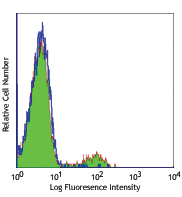- Clone
- Ber-ACT8 (See other available formats)
- Regulatory Status
- RUO
- Workshop
- V A067
- Other Names
- Integrin alpha E (ITGAE)
- Isotype
- Mouse IgG1, κ
- Ave. Rating
- Submit a Review
- Product Citations
- publications
| Cat # | Size | Price | Quantity Check Availability | Save | ||
|---|---|---|---|---|---|---|
| 350202 | 100 µg | 101€ | ||||
CD103 is a type I transmembrane glycoprotein also known as αE integrin, integrin αIEL chain, and human mucosal lymphocyte antigen 1. It belongs to the integrin family and is primarily found on intestinal intraepithelial lymphocytes (IEL). CD103 is also expressed on a subpopulation of lamina propria T cells, epithelial dendritic cells, lamina propria-derived dendritic cells, and a small subset of peripheral lymphocytes. Treg cells express high level of CD103. Hairy cell leukemia has also been shown to express CD103. The expression of CD103 on lymphocytes can be induced upon activation and TGF-β stimulation. In association with integrin β7, CD103 is expressed as an αE/β7 heterodimer. Mature CD103 protein can be cleaved into 2 chains, a 150 kD (C-terminal) chain and a 25 kD (N-terminal) chain, which remain linked by disulfide bonds. CD103 binds to E-cadherin and mediates homing of lymphocytes to the intestinal epithelium.
Product DetailsProduct Details
- Reactivity
- Human
- Antibody Type
- Monoclonal
- Host Species
- Mouse
- Immunogen
- HTLV-1 induced human T cell line MAPS16
- Formulation
- Phosphate-buffered solution, pH 7.2, containing 0.09% sodium azide.
- Preparation
- The antibody was purified by affinity chromatography.
- Concentration
- 0.5 mg/mL
- Storage & Handling
- The antibody solution should be stored undiluted between 2°C and 8°C.
- Application
-
FC - Quality tested
WB, IP, IHC-F - Reported in the literature, not verified in house - Recommended Usage
-
Each lot of this antibody is quality control tested by immunofluorescent staining with flow cytometric analysis. For flow cytometric staining, the suggested use of this reagent is ≤ 0.5 µg per million cells in 100 µL volume. It is recommended that the reagent be titrated for optimal performance for each application.
- Application Notes
-
Additional reported applications (for the relevant formats) include: Western Blotting1, immunoprecipitation1, and immunohistochemical staining of frozen tissue sections1.
- Application References
-
- Kruschwitz M, et al. 1991. J. Clin. Pathol. 44:636. (WB, IP, IHC-F)
- Yoshino N, et al. 2000. Exp. Anim. (Tokyo) 49:97. (FC)
- Product Citations
- RRID
-
AB_10639864 (BioLegend Cat. No. 350202)
Antigen Details
- Structure
- Type I transmembrane glycoprotein, integrin family; can be cleaved into 150 kD and 25 kD chains; associated with β7 integrin
- Distribution
-
Majority of intestinal intraepithelial lymphocytes (IEL), subpopulation of lamina propria T cells, epithelial dendritic cells, small subset of peripheral lymphocytes, Treg cells; expressed on hairy cell leukemia
- Function
- Retention and activation of CD103+ lymphocytes in the intestinal epithelium, regulation of tissue-specific T cell homing
- Ligand/Receptor
- E-Cadherin
- Cell Targets
- Integrin β7
- Cell Type
- Dendritic cells, Lymphocytes, T cells, Tregs
- Biology Area
- Cell Biology, Immunology, Neuroscience, Synaptic Biology
- Molecular Family
- Adhesion Molecules, CD Molecules
- Antigen References
-
1. Parker CM, et al. 1992. P. Natl. Acad. Sci. USA 89:1924.
2. Kruschwitz M, et al. 1991. J. Clin. Pathol. 44:636.
3. Schon MP, et al. 1999. J. Immunol. 162:6641.
4. Shaw SK, et al. 1994. J. Biol. Chem. 269:6016. - Gene ID
- 3682 View all products for this Gene ID
- UniProt
- View information about CD103 on UniProt.org
Customers Also Purchased
Compare Data Across All Formats
This data display is provided for general comparisons between formats.
Your actual data may vary due to variations in samples, target cells, instruments and their settings, staining conditions, and other factors.
If you need assistance with selecting the best format contact our expert technical support team.
 Login / Register
Login / Register 













Follow Us